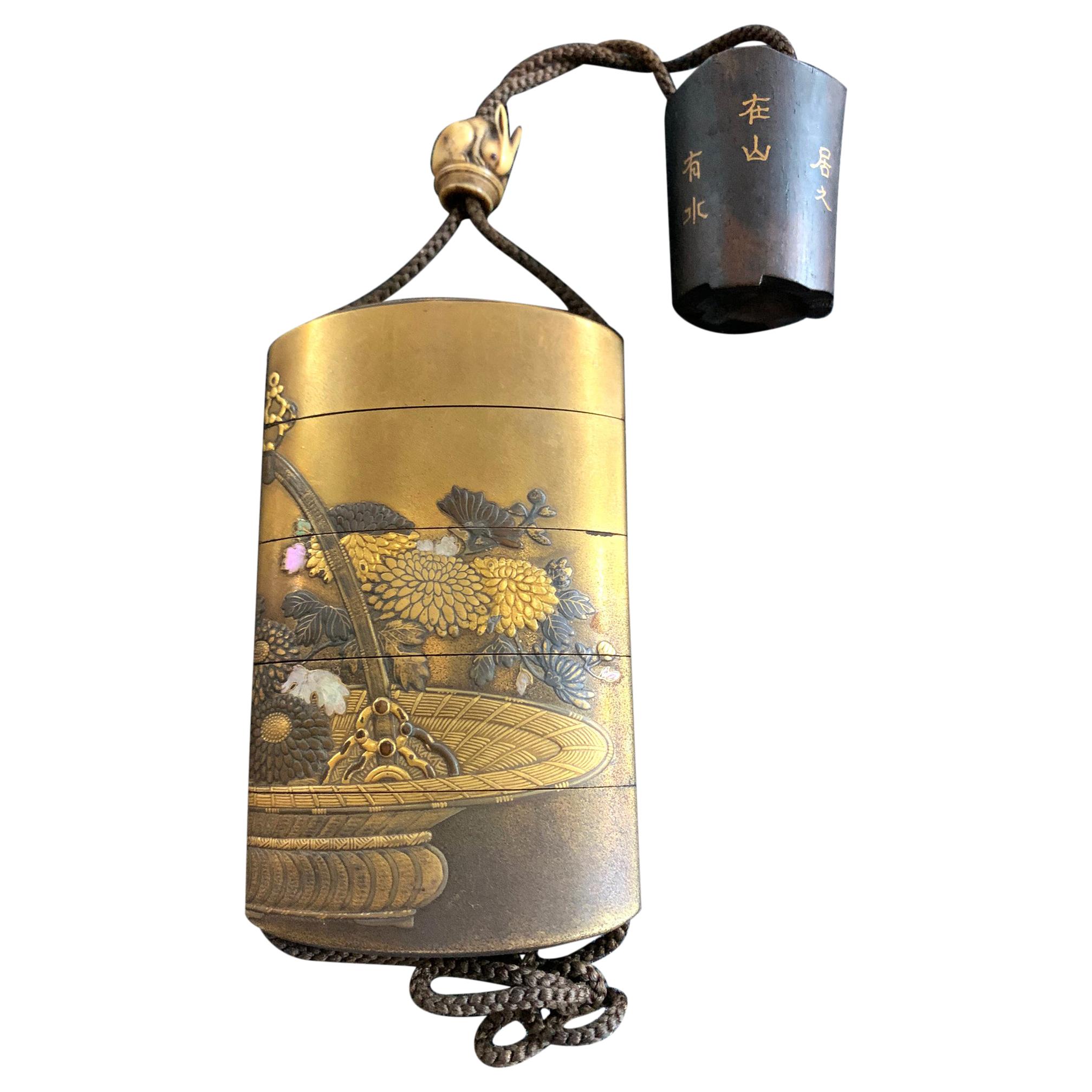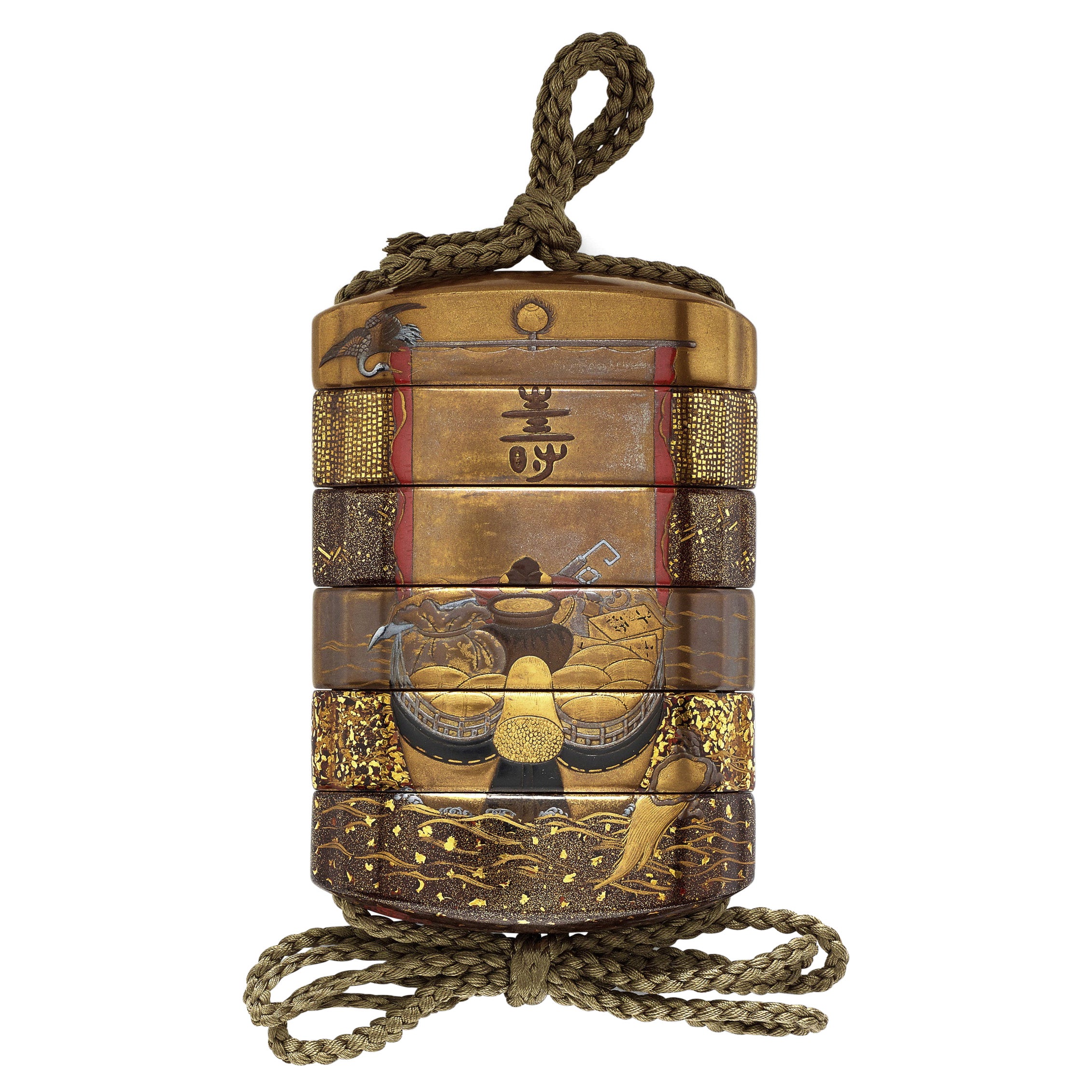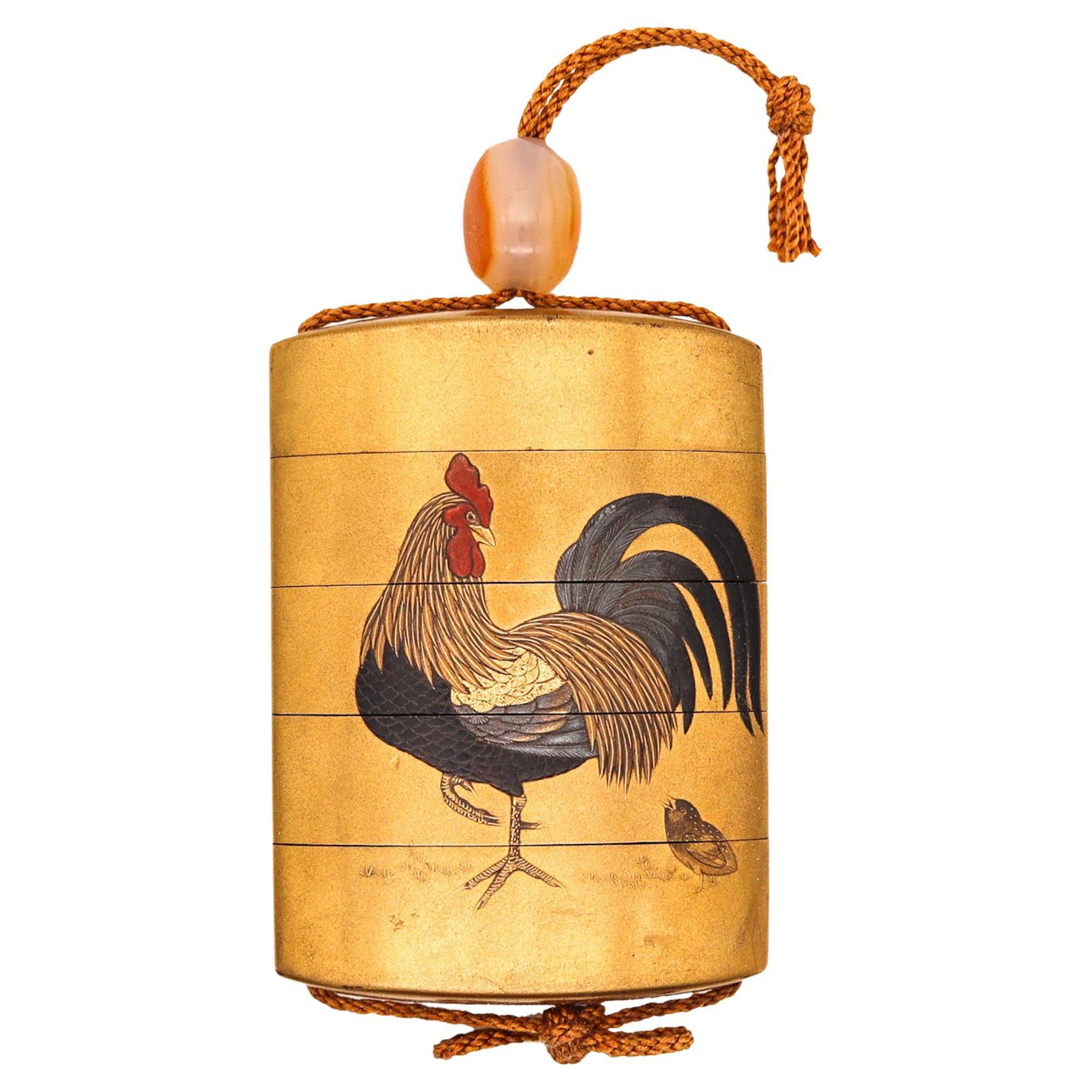Items Similar to Japan, Late 18th Century Gold Lacquer Inro by Kajikawa, Edo Period
Want more images or videos?
Request additional images or videos from the seller
1 of 6
Japan, Late 18th Century Gold Lacquer Inro by Kajikawa, Edo Period
About the Item
Late 18th century Inro by Kajikawa. Edo period
Beautiful inro in gold lacquer representing a continuous landscape on both sides.
The interior in Nashiji lacquer.
Some small traces of use but good general condition.
Japan, late 18th.
- Dimensions:Height: 3.86 in (9.8 cm)Width: 1.97 in (5 cm)Depth: 1.03 in (2.6 cm)
- Materials and Techniques:Lacquer,Lacquered
- Place of Origin:
- Period:
- Date of Manufacture:1790
- Condition:Wear consistent with age and use. Some wears on the lacquer as often but nothing important, all visible on pictures.
- Seller Location:PARIS, FR
- Reference Number:1stDibs: LU6491234048382
About the Seller
5.0
Vetted Seller
These experienced sellers undergo a comprehensive evaluation by our team of in-house experts.
1stDibs seller since 2022
Typical response time: 4 hours
- ShippingRetrieving quote...Ships From: PARIS, France
- Return PolicyA return for this item may be initiated within 3 days of delivery.
More From This SellerView All
- Japan, a Late 18th Century Imari Charger, Edo PeriodLocated in PARIS, FRNice hand painted Porcelain charger in the Imari palette using underglaze cobalt bleu and iron red. Japan, Edo period, late 18th century.Category
Antique Late 18th Century Japanese Ceramics
MaterialsPorcelain
- Japanese Lacquer Stacking Box, Jubako, Japan, Meiji Period, 19th cLocated in PARIS, FROptimise this text as-dding cultural information and good SEO optimisation. Then translate into French: Japanese Lacquer Stacking Box, Jubako, Japan, Meiji Period, 19th c Antique L...Category
Antique 19th Century Japanese Decorative Boxes
MaterialsLacquer
- Japanese porcelain blue and white Bowl, Japan , Arita Edo period, 18th CenturyLocated in PARIS, FRThis exquisite large Japanese porcelain bowl from Arita is in impeccable condition, boasting no signs of restoration. Its exterior showcases continuous karakusa scrolls inspired by t...Category
Antique 18th Century Japanese Edo Decorative Bowls
MaterialsPorcelain
- A set of 3 Kenjo-Imari porcelain Dishes, Japan Edo Period, 18th century.Located in PARIS, FRA set of 3 Japanese porcelain Kenjo-Imari Dishes, Japan Edo Period, 18th century. 3 Imari octagonal porcelain dishes. Underglaze cobalt blue, enamels and gold. The decoration in the ...Category
Antique 18th Century Japanese Ceramics
MaterialsPorcelain
- Large Japanese Cloisonné Box and Cover, Japan, Meiji Period, 19th CenturyLocated in PARIS, FRA rare Japanese bark tree large cloisonné box on metal from the Meiji period. Usually bark tree cloisonné was on porcelain (totai Shippo) A very attracti...Category
Antique Late 19th Century Japanese Metalwork
MaterialsMetal
- Chinese Cinabar Lacquer Hand Carved Box, China, Qing Dynasty 19th c.Located in PARIS, FRA fine antique Chinese red cinnabar lacquer lidded round box carved with a scene with a man working and a mother holding a child within a rocky landscape with trees. The "dragon's...Category
Antique Mid-19th Century Decorative Boxes
MaterialsLacquer
You May Also Like
- Fine Japanese Lacquered Inro with Inlays by KajikawaLocated in Atlanta, GAA Japanese four-case lacquer inro by a member of Kajikawa family circa 19th century (late Edo to early Meiji period). It depicts a nocturnal scenery of a meandering stream surrounded by bush clovers, where a full moon is reflected on the water. It was masterfully decorated in gold and silver maki-e using a combination of techniques including takamakie, togidashi and kirigane as well as aogai (abalone shell) inlays. The stream was set between the slightly elevated banks, adding to this piece a already strong three-dimensional composition. The interior was decorated in gold nashiji. It was signed on the bottom "Kajikawa Zou" (made by Kajikawa and a pot seal centered with "Ei" in Kanji. In one of the compartment, there is a katakana mark, appears to be a name, possibly the owner. Kajikawa clan was one of the most famous lacquer artisanal family established in the 17th century. Many well known members over the generations produced lacquer art in a wide range of formats, but two third were signed only with the family name such as this one. It is therefore not possible to pinpoint the exact author of this piece. Provenance: This inro was purchased as lot 349 in Christie's New York sale Japanese...Category
Antique 19th Century Japanese Japonisme Lacquer
MaterialsShell, Wood, Lacquer
- Antique Japanese Inro by Shigehide Edo PeriodLocated in Atlanta, GAThis exquisite four-case lacquered inro was dated to the latter part of 18th century to early 19th century (Edo period) and made by Shigehide. The opposite sides of the inro together features a lavish flower arrangement in a bamboo basket (ikebana). The detailed craftmanship was a true pleasure to behold. Mostly Takamaki-e (high relief) were used to texturize the delicate petals of the chrysanthemums, on which different shades of gold were used to create contrast. Raden (mother of pearl) shells were also used to highlight some leaves, rendering the piece an interesting balance of color and material. The interior was completed in a mottled gold finish. It was signed Shigehide on the bottom with a Kao. There is a small carved rabbit ojime bead...Category
Antique Late 18th Century Japanese Japonisme Lacquer
MaterialsWood, Lacquer
- Japanese Inro by Koma Koryu Edo PeriodLocated in Atlanta, GAA four-case lacquered inro by Koma Koryu circa 19th century late Edo period. The inro features a pair of Chinese mandarin duck resting under a bundle of blooming irises on the pond. ...Category
Antique 19th Century Japanese Japonisme Lacquer
MaterialsWood, Lacquer
- Five-Case Inrō 19th Century Signed Kajikawa Saku Japanese Lacquer BoxLocated in Milano, ITSigned: “Kajikawa saku” and with a red pot seal Height: 3 1/8in (7.9cm) Provenance: Michael Tomkinson Collection Leonard Haber Collection Literature: Michael Tomkinson, A Japanese Collection, London: George Allen, 1898, no. 300 Each case with slightly recessed joints and with different grounds, including kinji, nashiji, togidashi maki-e and gyobu-nashiji, on the obverse decorated with a treasure ship laden with the attributes of the Seven Gods...Category
Antique 19th Century Japanese Lacquer
MaterialsWood, Lacquer
- Rare Japanese Sumi-E Lacquer Inro Yamada Jokasai Edo PeriodLocated in Atlanta, GAA three-case lacquered Inro by Yamada Family circa 18th-19th century Edo period. The inro with slight rounded form is of Kano style and vividly depicts a dragon slithering among the ink clouds on a gold background. Sumi-e togidashi (ink togidashi) technique, in combination with Hiramaki-e, were employed to create the dreamy ambience of this piece. The dragon has a painterly appearance inspired by Chinese ink painting that was often seen on the Japanese folding screens. The back of the Inro was sparsely decorated with the shifting patterns of the darkening clouds with an emphasis on the space intentionally left empty. Jokasai was signed to the base. On the front of the inro there is another miniature signature Hakugyoku Hogen, which is one of names used by Kano Michinobu (1730-1790). The dragon is evidently one of his designs (see reference below). Established by a member of Yamada family in the 17th century, the clan was one of the most prominent lacquer artisanal family for the next 200 years until the end of Edo period in the 19th century. Most members signed their work simply with Jokasai making the identification of the individual artists somewhat impossible. The current Inro on offer, compared to many other pieces by Jokasai, has an uncommon Kano style done in Sumi-e togidashi. Another unusual feature of this piece is that the interiors of the inro was decorated with an interesting gold mosaic inlays (kirigane) on a dark lacquer background, giving it a jewel like quality. For another Inro by Jokasai of a similar style using Sumi-e togidashi but depicts a tiger, see Wrangham collection, no.353, which was offered for sale as lot 256 in Bonham's London Auction: The Edward Wrangham Collection of Japanese Art Part I. 9 Nov 2010. For an ink scroll...Category
Antique 18th Century Japanese Japonisme Lacquer
MaterialsWood, Lacquer
- Japan 1810 Kajikawa Edo Period Five Drawer Inro Lacquered Gilt Wood With RoosterLocated in Miami, FLJapanese Inro from the Edo period (1615-1868) created by Kajikawa. Beautiful Inro, created in Japan by one of the Kajikawa family during the Edo period (1615-1868), circa 1810. Has been carefully crafted in carved precious wood with applications of gilding maki-e and decorated with Japonism patterns. All dan trays are attached together with a himo cord. The detailed craftsmanship was a true pleasure to behold. Period: Edo period (1615-1868). Shogunate. Approximate Date: 1790-1810 Motif: A family of birds consisting of a cockerel, the hen and three chicks. Drawers: Five. Shape: Rectangular navette. Technique: Carved wood, lacquer and decorated in iroe-hiramaki-e on a gold ground. Ojime: 15mm 20mm, oval carved from natural translucent agate. Netsuke: None Weight: 47.70 Grams. Measurements: Inro is 78 mm by 55 mm by 18 mm (3.07 x 2.17 x 0.71 Inches). Signatures: Kajikawa Saku, in the underside with the signature KAJIKAWA. By a member of the Kajikawa family, signed Kajikawa 梶川 Japan, late 18th century to early 19th century, Edo period (1615-1868). The Kajikawa family Kajikawa family, flourished in the 19th century, they was Japanese lacquerware artists whose school in Edo (now Tokyo) flourished for more than 200 years. This family is perhaps the most famous of all the dynasties of Japanese lacquer artists, and certainly the name most often found on inro. The family is said to have been founded by Hikobei at Edo in the early 17th century, although some claim that the family’s great reputation really stemmed from his son and pupil Kyujiro. In any event, Hikobei worked for the shogunate, as did his successors until well into the 19th century. Kijirō excelled in designing particularly delicate lacquer inrō, portable medicine cases...Category
Antique 1810s Japanese Edo Lacquer
MaterialsAgate, Gold





